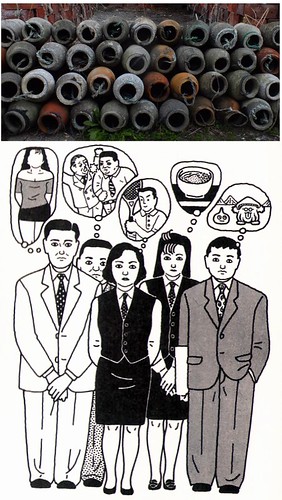Friday, October 28, 2016
Japanese Trick
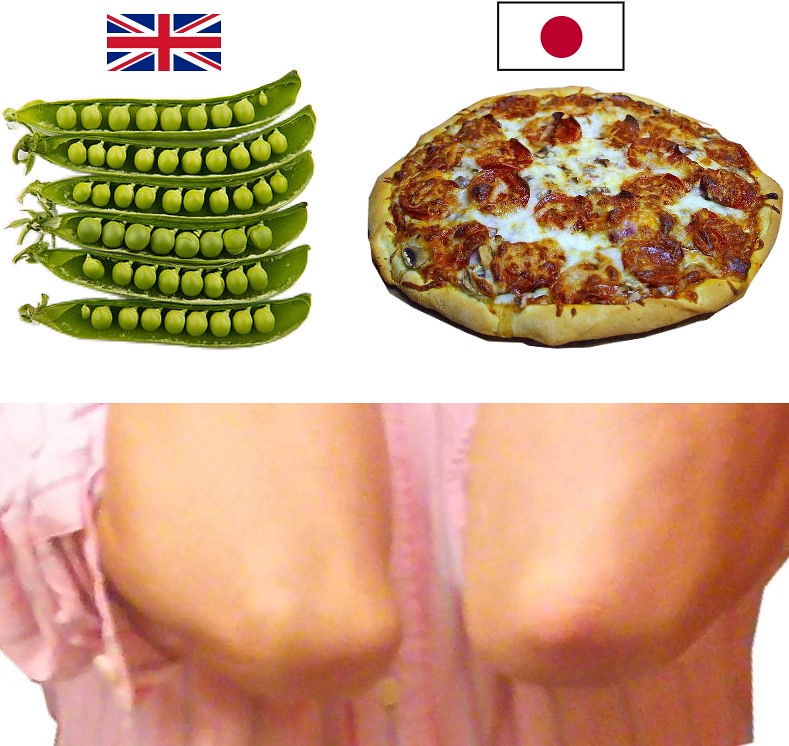
Name the food item below your flag, saying it aloud, ten times and then name the body part in the lower part of the picture. The Japanese for pizza (piza) rhymes with the Japanese for knees, and since elbows somewhat resemble knees in appearance and the word for knees and elbows is simiilar (hiza and hiji respectively), Japanese who have been made to say piza ten times are inclined to call their elbows knees. I don't think that even if a Briton were asked for say peas one hundred times before naming the body part they would ever call their elbows knees and not only because the two words are less similar but also because their is a greater phoneme to meaning connection felt by anglophones, compared to Japanese who feel meaning to be conveyed more strongly by images.
Labels: blogger, japanese culture, japaneseculture, nihonbunka, 日本文化
The Japanese Hate Puns
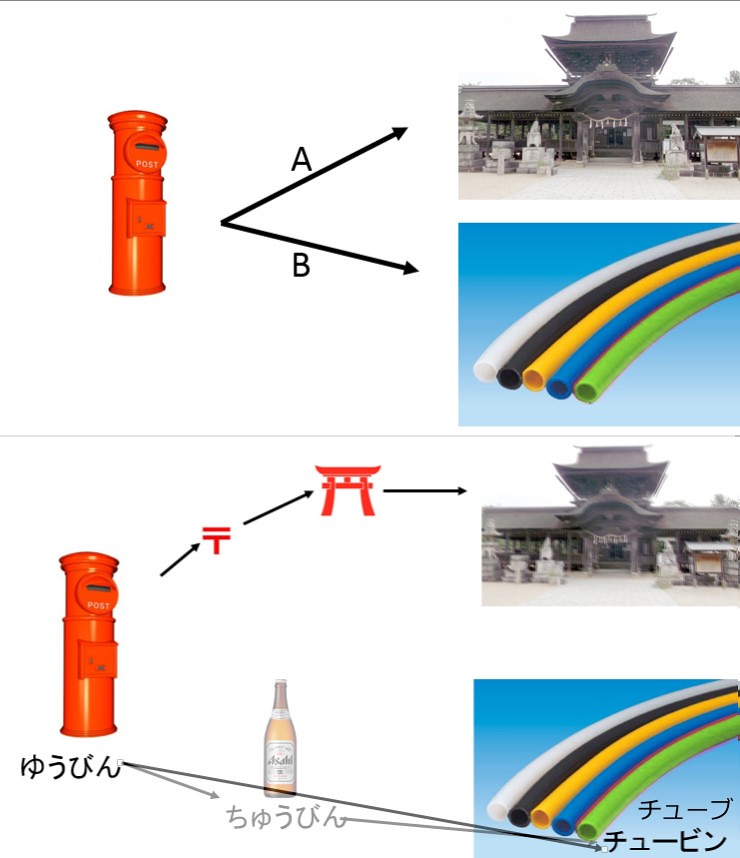
I used to marvel at the fact that one of the most famous brands of watch in Japan is a pun on coitus (Seikou) among a variety of other things. To the Japanese it is not the slightest bit notable nor amusing. There are too many homonyms and puns in the Japanese language for anyone to find them funny. Meaning is expressed by pictorial characters more than phonemes and many of these characters are read with the same phoneme so unless one calls to mind the character the phoneme is polysematic by itself. Making sequences of assocations to test the hypothesis is very difficult to make associations that do not run along more than one, both linguistic and visual, line. The linguistic association post box (yuubin posuto) to some tubing (chuubin) either vian a mid sized bottle (chuubin) to tube (chuubu) or not, could also be made visually and directly due to the fact that a post box is tubular. I am not sure if anyone else would associate the post office mark with the mark for shrines. And the post box could be associated directly with the shrine as both being associated with the Japanese state: as an instantiation of what was Japan post and the Japanese state religion. In any event, punning associations are likely to be weak in Japan. Japanese people generally just cringe when jokes are attempted with puns. Images from the Google image search. お取り下げご希望の場合は下記のコメント欄か、http://ift.tt/2doaLKR
Labels: blogger, japanese culture, japaneseculture, nihonbunka, 日本文化
Pizza Elbow Japan

It is my view that the Japanese mind may in fact have a stronger network of visual associations shown bottom left such that I hypothesise that pizza would be felt to visually resemble the Japanese flag, which is in turn associated with a map of Japan so, there is an indirect visual association between pizza and the shape of the Japanese archipelago. I hypothesize that these visual associations would be stronger than the former linguistic associations among Japanese compared to Westerners, but this would be difficult to prove since the same linguistic associations could not be made.
Instead of the elbow, an anglophone might be asked if they associate the pizza with a fridge symbol using the association by rhyme of pizza -> freezer and the association by first letter and physical similarity freezer -> fridge. But then pizza is kept in a fridge so even if anglophones chose it they might be doing so due to holistic associations of visual contiguity. I think I would need to use Japanese subjects and some sort of priming manipulation of culture.
The pizza elbow connection is used by Japanese school boys in a sort of trick where the victim is asked to say pizza ten times before being asked the name of the elbow, which instead of calling a hiji (elbow) is inclined to call a "hiza" having been influenced by the repetition of pizza (piza in Japanese). I think that this trick works also shows that Japanese are fairly insensitive to phonetic semantic connections. If I were told to repeat "pea" ten times I would not call my elbow my knee.
お取り下げ後希望の場合は下記のコメント欄か、http://nihonbunka.comで掲示されるメールアドレスに誤一筆ください。Should the owner of the copyright of the thumbnails used above wish that I stop using them then please be so kind as to drop me a note in the comments below or to the email link on my website nihonbunka.com
Labels: blogger, japanese culture, japaneseculture, nihonbunka, 日本文化
Pizza Elbow Japan

It is my view that the Japanese mind may in fact have a stronger network of visual associations shown bottom left such that I hypothesise that pizza would be felt to visually resemble the Japanese flag, which is in turn associated with a map of Japan so, there is an indirect visual association between pizza and the shape of the Japanese archipelago. I hypothesize that these visual associations would be stronger than the former linguistic associations among Japanese compared to Westerners, but this would be difficult to prove since the same linguistic associations could not be made.
Instead of the elbow, an anglophone might be asked if they associate the pizza with a fridge symbol using the association by rhyme of pizza -> freezer and the association by first letter and physical similarity freezer -> fridge. But then pizza is kept in a fridge so even if anglophones chose it they might be doing so due to holistic associations of visual contiguity. I think I would need to use Japanese subjects and some sort of priming manipulation of culture.
お取り下げ後希望の場合は下記のコメント欄か、http://nihonbunka.comで掲示されるメールアドレスに誤一筆ください。Should the owner of the copyright of the thumbnails used above wish that I stop using them then please be so kind as to drop me a note in the comments below or to the email link on my website nihonbunka.com
Labels: blogger, japanese culture, japaneseculture, nihonbunka, 日本文化
Thursday, October 27, 2016
No Need to Hear What They are Saying
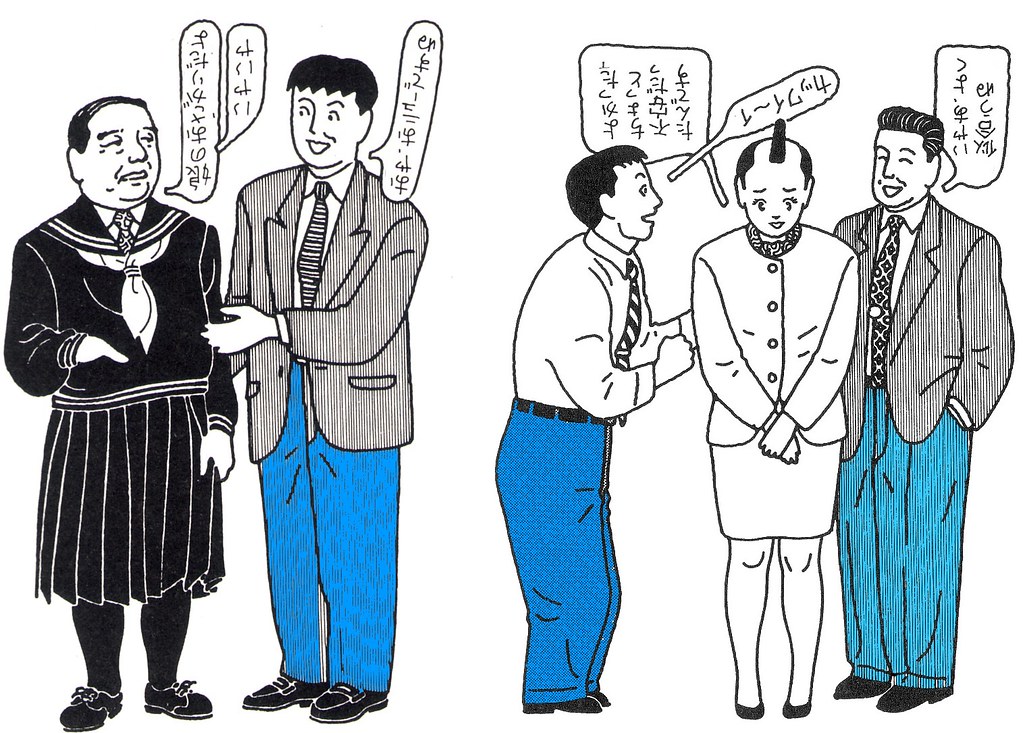
I confess that I am still inclined to say "thank you," and accept the linguistic content as if it were meant sincerely, socially inept as I am.
Images originally in black and white by Michio Hisauchi in Ishihara, 2006, p21 and p23
お取り下げご希望の場合は下記のコメント欄か、http://nihonbunka.comで掲示されるメールアドレスにご一筆ください。
Bibliography
Barthes, R. (1983). Empire of Signs. (R. Howard, Trans.). Hill and Wang.
Hall, E. T. (1976). Beyond Culture. Anchor Press.
Hendry, J. (1995). Wrapping Culture: Politeness, Presentation, and Power in Japan and Other Societies. Oxford University Press, USA.
Ishihara, S. 石原壮一郎. (2006). 大人養成講座 (PB版). 東京: 扶桑社.
McLuhan, M., & Fiore, Q. (1967). The Medium Is the Massage. JSTOR. Retrieved from www.jstor.org/stable/30217390
Labels: blogger, japanese culture, japaneseculture, nihonbunka, 日本文化
Wednesday, October 26, 2016
Reading the Customers Mind
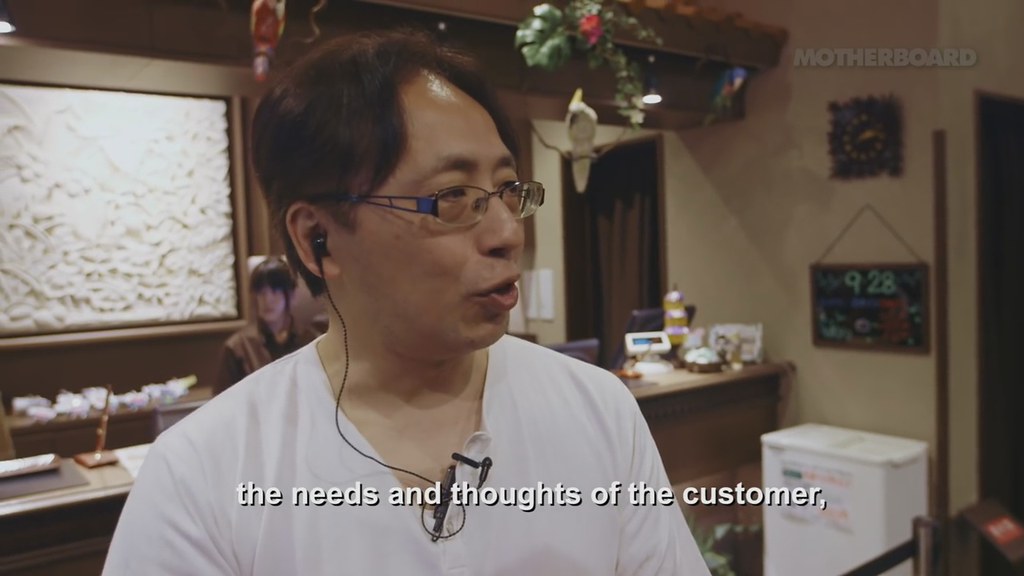
A Japanese capsule hotel manager, Akikazu Fukumoto, explains the essence of Japanese style hospitality (omotenashi) and why it would be impossible to replace his staff with robots in two sentences,
at the three minute mark in a video on robot staffed hotels in Japan by Motherboard.
My translation (for the original Japanese see below)
"Our hotel has the heart of Japanese hospitality (omotenashi no kokoro) and must therefore be staffed by humans. Our staff must be human because we behave proactively anticipating the thoughts and needs of the customer. "
The Motherboard translation is slightly off the mark since the hotelier does not "respond" to the needs and thoughts of the customer but pre-empt -- saki mawari, literally go around in front of -- them. If it were merely a case of "responding" to the needs and thoughts of their guests, the hotel could wait for the guests to express them verbally, and use robots, or untrained staff working to a manual, as is the case in Western style, customer makes overt choices, "help yourself" (Doi, 1973, p.13) hospitality.
Japanese hospitality is, when it works, a sort of "mirror dance" (Krieger, 1983) where the providers read the minds of their customers via their faces and behaviour, adjusting their own behaviour on the fly accordingly.
Contra what I have written elsewhere however, this hotelier seems to be implying that the thoughts of the customer are not expressed by their behaviour but come afterwards, perhaps in linguistic form. At its most effective, Japanese hospitality should preempt, and even prevent, the arrival of such thoughts by satisfying the need before the thought arises. The manager also mentions however, a "heart" (kokoro) that exist prior to the thought, at least in the hotelier. This Japanese heart has traditionally been refereed to as a mirror such as in the preface to the record of ancient matters (Kojiki).
Bibliography
Doi, T. (1973). The Anatomy of Dependence. Kodansha USA.
Krieger, S. (1983). The Mirror Dance: Identity in a Women’s Community. Philadelphia: Temple Univ Press.
うちのホテルにはおもてなしの心があるんで、人間じゃないとだめです。お客様のほしいこと、もしくは思っていることを先回りして考えてこうどうするんで、やっぱりおもてなしのこころは人間じゃないとだめだと
The "please help yourself" that Americans use so often had a rather unpleasant ring in my years before I became used to English conversation. The meaning, of course, is simply "please take what you want without hesitation," but literally translated it has some a flavour of "nobody else will help you," and I could not see how it came to be an expression of good will. The Japanese sensibility would demand that, in entertaining, a hose should should sensitivity in detecting what was required and should himself "help" his guests. To leave a guest unfamiliar with the house to "help himself" would seem excessively lacking in consideration. This increased still further my feelings that Americans were a people who did not show the same consideration and sensitivity towards others as the Japanese. As a result, my early days in American, which would have been lonely at any rate, so far from home, were made lonelier still. (Doi, 1973, p.13)
Labels: blogger, hospitality, japanese culture, japaneseculture, nihonbunka, 日本文化
Tuesday, October 25, 2016
Life Expectancy vs Health: A Liars Paradox
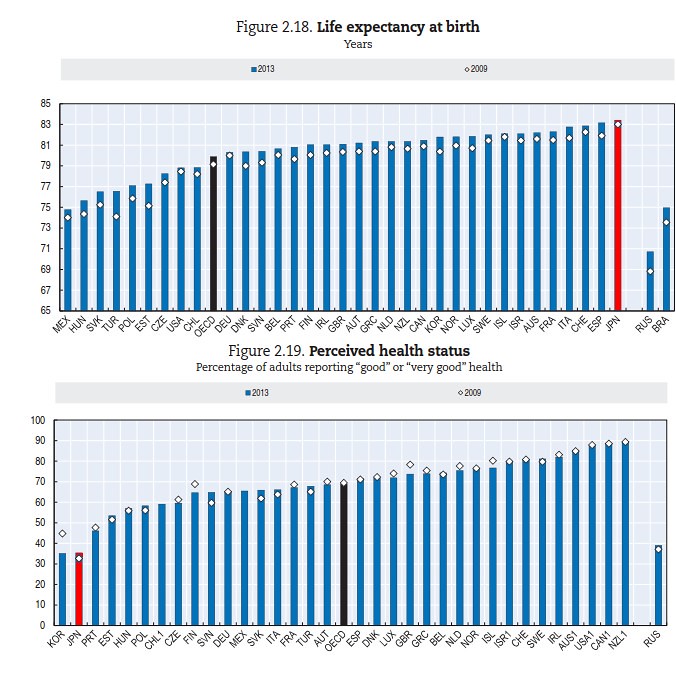
Life Expectancy vs Health: A Liars Paradox
It is quite difficult to get objective data about the well being and health of a nation. In research on perceived well being (Cummings, 1998) based upon Licket scaled linguistic tests developed by Diener (Diener, Emmons, Larsen, & Griffin, 1985), the Japanese are found to be among the most unhappy people in the world. There are a number of reasons for this. The reference group effect (Heine, Lehman, Peng, Greenholtz, 2002) encourages respondents to compare themselves to their ingroup peers, so if those surrounding the subject are happy it is going to be difficult to rate oneself as of above average well-being or happiness. And further, while Asians tend to be humble, Westerners tend to "self-enhance."
Alas however, despite the lack of reliability of self-report measures, the prime minister of Japan (Abe, 2013) is alarmed by the fact that Japanese children do not, like American children, self-report that they are "proud of their country. The lack of pride of the Japanese is seen as cause for concern.
But the results to these self-report surveys should in my view be ignored. One of the most obvious ways to out the lack of veracity of the self report data is to compare life expectancy with self-reports of health. The Japanese have the highest life expectancy of any country in the OECD survey, but together with their Asian neighbour, the lowest response in rates of "good" or "very good" in answer to "“How is your health in general?”
That 35.4% of the Japanese report themselves to be in the top two categories of a five point scale is within 4.6% of the level that it should be assuming realism and an honest, parsimonious, even distribution of people responding with each of the five categories. More than 80% of people from the top four anglophone countries, however, find it meaningful to say that their health is "good" or "very good". What does "good" or "very good" mean to these people? It is clearly not an expression of the true state of their health. I suspect it is self encouragement, or auto-eroticism as Derrida (1976) likes to call it. In the Christian tradition pride was thought to be the origin of or equivalent to sin(Hastings, Mason, & Pyper, 2000) but these days positivity is king.
All these self-report scales should indicate is that the Japanese do not lie about their happiness and health. Alas there are many Japanese who believe the data, and believe that they are as a nation, living a long time in poor health compared to other nations. Concerned at these results Japanese children, and adults, are being encouraged to rate themselves more positively. The whispering is being imported to Japan.
Graphs from p.72 OECD (2015) How's Life? 2015 Measuring Well-being DOI:10.1787/how_life-2015-en
Bibliography
Abe. S., 安倍晋三. (2013). 新しい国へ 美しい国へ 完全版 (『美しい国へ』増補・再編集・改題書版). Tōkyō: 文藝春秋.
Cummins, R. A. (1998). The second approximation to an international standard for life satisfaction. Social Indicators Research, 43(3), 307–334. Retrieved from link.springer.com/article/10.1023/A:1006831107052
Derrida, J. (1976). Of grammatology, trans. G. Spivak. Baltimore: Johns Hopkins University.
Hastings, A., Mason, A., & Pyper, H. (2000). The Oxford Companion to Christian Thought. Oxford, England: Oxford University Press.
Heine, S. J., Lehman, D. R., Peng, K., & Greenholtz, J. (2002). What's wrong with cross-cultural comparisons of subjective Likert scales?: The reference-group effect. Journal of personality and social psychology, 82(6), 903.
Labels: blogger, japanese culture, japaneseculture, nihonbunka, 日本文化
Saturday, October 22, 2016
After the Bubble: Why haven't the Japanese bounced back?

Western meritocracy based management styles arrived at about the time as the economic bubble burst, in the early nineties (Myung T. S., 2013) with a view to curing the post bubble depression. Till then the Japanese had imported Western technological expertise but had employed it with the vigour and enthusiasm of the Japanese soul (wakonyousai 和魂洋才) or psychology. These Western methods of ability and performance evaluation are destroying the non logocentric (non-linguistically-formulated, non-codified, non-rational) company culture that made Japanese companies great.
The Japanese salarymen in newly meritocratic companies are like the think aloud group in Heejung Kim’s brilliant (2002) "We Talk therefore We Think," experiment in which the problem solving ability of East Asians was reduced. Linguistic self-appraisal is at variance to the lived autoscopic (Heine, Takemoto, Moskalenko, Lasaleta, & Henrich, 2008; Takemoto, T., 2003) tradition, and so results in a sort of double bind, that just wears the Japanese down.
Till then Japanese companies codified and evaluated their employees in different ways (De Mente, 1990). It was not that Japanese companies were completely without performance objectives but that they were not put into words. Not all employees were deemed fit to keep rising through the ranks (nekoujouretsu 年功上列). Some employees were sent out into the sticks (sasen 左遷) or left by the window (madogiwazoku 窓際族) if they did not put in the graft. But employees were not graded according to their TOEIC score or their sales gross. Rather than encouraging everyone to merge with and assess themselves according to the linguistically defined company objectives, it was recognised that that a plurality of person types, achievers, the able, and facilitators, go to make a good company team (Yuki, 2003).
Places like Toyota with enough strength of tradition call paperwork (shiryou 資料) quantum of death (shiryou 死量) (Wakamatsu, 2007) but I fear they'll all go down the tubes, like Mitsubishi, eventually with the big now governmental push for linguistic quantisation, standards and objectives.
To take an analogy from Japanese mythology I could say that the mirror of the Sun Goddess is being hidden by the whispering of flies, but that would make it sound all too arcane and mystical. There is nothing particularly arcane or mystical about the way in which the Japanese did business. The Japanese did business like tennis players play tennis. If you ask a tennis player how come they do such a great serve they will become worse at it due to the additional cognitive load of having to describe the motion of their racket (Eagleman, 2012, p. 74). Likewise if you are designing a beautiful car then you don't want to mess around with paperwork and checkboxes.
It would take a long time before the Japanese are reborn as whisperers who like to listen to themselves think (Derrida, 1998), so I fear they have a long way down to go. It is all very logical but very sad. Other than Derrida and Luther their are few critics of reason, and it may even be possible for subalterns (Spivak, Nelson, & Grossberg, 1988) to criticise, so what can they do? And now alas with all their money printing, which is perhaps the whispering on a global economic scale, the Japanese may have entered into a very unfortunate type of pact. But I live in hope.
What can be done? Perhaps Toyota managers need to become politicians. Perhaps as Uichol KIm has argued, there could be increases in literal transparency in terms of open-plan offices, glass doors, visitation, the publication of results in photographic and "signage" (kanban 看板) form. It could also be argued that the Japanese need to alert to themselves once again, to the dangers of printing money and praising the self. At the psychological level these are low self esteem or 'outgroup discrimination' (Tajfel & Turner, 1979). At a geopolitical level I fear these may translate into inflation or military conflict.
Bibliography
De Mente, B. (1990). Japan’s Secret Weapon: The Kata Factor : The Cultural Programming That Made the Japanese a Superior People (1st ed.). Phoenix Books.
Derrida, J. (1998). Of Grammatology. (G. C. Spivak, Trans.). JHU Press.
Eagleman, D. (2012). Incognito: The Secret Lives of the Brain (Reprint edition). New York: Vintage.
Heine, S. J., Takemoto, T., Moskalenko, S., Lasaleta, J., & Henrich, J. (2008). Mirrors in the head: Cultural variation in objective self-awareness. Personality and Social Psychology Bulletin, 34(7), 879–887. Retrieved from www2.psych.ubc.ca/~heine/docs/2008Mirrors.pdf
Kim, H. S. (2002). We talk, therefore we think? A cultural analysis of the effect of talking on thinking. Journal of Personality and Social Psychology, 83(4), 828. Retrieved from labs.psych.ucsb.edu/kim/heejung/kim_2002.pdf
Myung T. S. 明, 泰淑. (2013). 日本企業の成果主義人事制度の現状と課題. 産研論集, 44(45), 15. Retrieved from sapporo-u.repo.nii.ac.jp/?action=repository_action_common...
Spivak, G. C., Nelson, C., & Grossberg, L. (1988). Can the Subaltern speak. In Marxism and the Interpretation of Culture (pp. 271–313).
Tajfel, H., & Turner, J. C. (1979). An integrative theory of intergroup conflict. The social psychology of intergroup relations?, 33, 47.
Takemoto, T. (2003). 言語の文化心理学―心の中のことばと映像(The Cultural Psychology of Language: Language and Image in the Heart). In 武本, ティモシー & 古賀,範理, あなたと私のことばと文化―共生する私たち―. 五絃舎.
Yuki, M. (2003). Intergroup comparison versus intragroup relationships: A cross-cultural examination of social identity theory in North American and East Asian cultural contexts. Social Psychology Quarterly, 166–183. Retrieved from www.jstor.org/stable/pdfplus/1519846.pdf
若松義人. (2007). トヨタの上司は現場で何を伝えているのか. Tōkyō: PHP研究所.
Takemoto, T. (2016) ジマンガー日本人の心像的自尊心の測定の試みー. in preparation.
Image from today's Asahi Newspaperお取り下げご希望でありましたら、下記のコメント欄かnihonbunka.comのメールリンクからご一筆いただければ幸いです。
Labels: japanese culture, nihonbunka, 日本文化
Sunday, October 16, 2016
Psychological Keynsianism Japanese Style
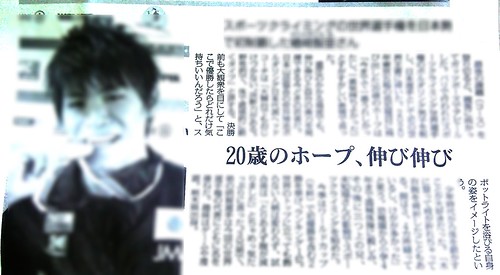
Westerners have a tendency for self praise. Indeed thought, which has been shown not to be will (Libet, 2009; Nisbett and Wilson, 1977) may be a stream of self comforting, justifications (Haidt, 2001), or even a negotiation" (Rochat, 2009) or sexual self-stimulation (Derrida, 1976) that we whisper and of which we are ashamed (Quran 50:16).
Whispering in the mind is similar to Keynesian macroeconomic stimulation of the fiscal kind. Westerners tell themselves that "I can do it," "I'll will win" and motivate themselve to do just that. They feed themselves empty simbols, that otherwise have exchange value, to get a postive feedback loop going. Central banks print money, symbols that otherwise have exchange value, to get an economic positive feedback loop going. Both work in the short term but may become an addictive maelstrom of self-stimulation in the longer term.
With regard to the mental self-stimulation it has been shown that the the Japanese probably do not do it, at least nearly so much (Kim, 2002; Heine et al., 1999). Japanese sports persons refrain from self praise even when they win. This is not to say that there is not a Japanese equivalent to self-praise. The sports person picture above in the Yamaguchi Newspaper indulged in Psychological Keynsianism Japanese style. Before the final of his rock climbing event he brought forth an imagine in his mind of himself, winning the event in the spotlight in front of the massive crowd. This image helped propell him to his win, with unconstrained enthusiam (nobi nobi 伸び伸び).
One possible advantage of the Japanese style of self-stimulation is that it may not require comparison (Yuki, 2003).
Linguistic signs always exist and have meaning in distinction to other signs (De Saussure, 2011; Maruyama et al., 1993, p19). "I will win" implies someone will loose. "I am great" implies, if "great" is to have any meaning, that someone else is not great. Unless there is to be rampant inflation some nefarious technique of maintaing the myth of 'everyone is better than average' must be brought into play. This is often achieved for instance by the negative evaluation of outgroups (Said, 1979; Tajfel and Turner, 2004). British people can be all "great", because orientals are all "savages". British people could all be rich because they took wealth from the rest of the world.
The Japanese are even better than Americans at maintaining a myth that everyone is better than average (Hamamura, Heine, & Takemoto, 2007). Their technique of just imagining the beauty, however, does not necessarily require downward comparison. In the case of the sportsperson above it is true he imagined himself winning but the important thing was that he was in the spotlight. Downwards comparison was not present nor necessary. Indeed conversely it may be the case that Japanese psychological Keynsianism can feed off positivity, such that Japanese like to imagine, and photograph, themselves alongside the triumph and beauty of others. Japanese tourists, armed with selfie-sticks are masters at 'basking in reflected glory' (Cialdini et al., 1976).
Japanese economic self-stimulation has generally taken the form of public works projects to construct roads, and various "boxy" (hakomono) infrastructure. Such public works were generally funded by loans. Perhaps Japanese sports person can only pump themselves up with images of victory if they accept that there will be a payback time (perhaps at the moment of victory, when the spotlight is not all that enjoyable after all).
Recently, both on the psychological and economic front however the current prime minister of Japan is encouging the Japanese to praise themselves (Abe, 2006), and resorted to symbolic, fiscal stimulation of the Japanese economy. The Bank of Japan is printing yen and purchasing Japanese government bonds. The Prime Minister also espouses an increase in Japanese millitary strength. It seems to me that simbolic self-stimulation, without inflation, and violence go hand in hand. I think that this physical recreation of the Western mind in the global pollitical economy is the 'unveiling' that we need to avoid.
Bibliography
Abe, S. (2006). Utsukushii kuni e [Towards a beautiful country]. Tokyo: Bungei Shunju.
Cialdini, Robert B., et al. "Basking in reflected glory: Three (football) field studies." Journal of personality and social psychology 34.3 (1976): 366.
Derrida, J. (1976). Of grammatology, trans. G. Spivak. Baltimore: Johns Hopkins University.
De Saussure, F. (2011). Course in General Linguistics [1916]. New York, NY: Columbia University Press.
Haidt, J. (2001). The emotional dog and its rational tail: a social intuitionist approach to moral judgment. Psychological review, 108(4), 814.
Hamamura, T., Heine, S. J., & Takemoto, T. R. (2007). Why the better-than-average effect is a worse-than-average measure of self-enhancement: An investigation of conflicting findings from studies of East Asian self-evaluations. Motivation and Emotion, 31(4), 247-259.
Heine, Steven J., Darrin R. Lehman, Hazel Rose Markus, and Shinobu Kitayama. "Is there a universal need for positive self-regard?." Psychological review 106, no. 4 (1999): 766.
Kim, H. S. (2002). We talk, therefore we think? A cultural analysis of the effect of talking on thinking. Journal of personality and social psychology, 83(4), 828.
Libet, B. (2009). Mind time: The temporal factor in consciousness. Harvard University Press.
Maruyama, M. et al. 丸山圭三郎, 行人柄谷, 健二立川, 秀岸田, & 芳郎竹内. (1993). 文化記号学の可能性 (増補完全). 夏目書房.
Nisbett, Richard E., and Timothy D. Wilson. "Telling more than we can know: Verbal reports on mental processes." Psychological review 84.3 (1977): 231.
Rochat, P. (2009). Others in mind: Social origins of self-consciousness. Cambridge University Press.
Said, E. W. (1979). Orientalism. Vintage.
Tajfel, H., & Turner, J. C. (2004). The Social Identity Theory of Intergroup Behavior.
Yuki, M. (2003). Intergroup comparison versus intragroup relationships: A cross-cultural examination of social identity theory in North American and East Asian cultural contexts. Social Psychology Quarterly, 166–183. Retrieved from www.jstor.org/stable/pdfplus/1519846.pdf
Image: Deliberately blurred photo of an article in the Yamaguchi Newspaper from October 2016.
お取り下げ希望でありましたら、下記のコメント欄かnihonbunka.comのメールリンクからご連絡ください。
Addendum
(The Rocking Horse Winner is a masterpiece with whispering, money and even a Buraq)
Labels: japanese culture, nihonbunka, 日本文化
Friday, October 14, 2016
The Japanese Octopus Pot Runneth Over
Masao Murayama's theory of the "octopus society" (MacFarlane, 2010) claims that Japanese society is like a lot of octopus pots (image above bottom cropped from wikimedia). Octopus pots are traps for Octopi. The Octopus crawls into the trap and thinks it is safe inside a hole in the seabed but in fact it is pulled up by a string. The Japanese are trapped within their pots which represent their minds, which are also claimed to be empty, lacking a centre. MacFarlane (2010, p78) paraphrases a Japanese source as saying "Our friend seemed to be saying the he imagined that westerners feel filled at the centre with an individual soul and personality, while a single Japanese is like an empty room," and Fukuzawa similarly as claiming ": 'The millions of Japanese at that time were closed up inside millions of individual boxes. They were separated from one another by walls with little room to move around (ibid).' A similar "empty centre," theory is espoused by the late great Jungian psychologist of Japanese mythology, Hayao Kawai (河合, 1982). Kawai seems to have forgotten about the mirror which the book of Japanese mythology claims is the heart of the Japanese (The Kojiki Preface).
These octopus pot, empty centre theories are the opinions of Japanese word merchants like Fukuzawa. As previously mentioned, the Japanese tradition was not to care "a hair on their heads" about such hot air. The Japanese care about "the warehouse of their acts" (Kai)">, or as far as they are yet to be completed, their dreams (as expressed by the picture by Michio Hisauchi, showing Japanese standing in an elevator in Ishihara, 2006, p53). Empty of words they have been demonstrated to be (Kim, 2002) but in my view the Japanese heart may lack a centre (who needs one?) and is not trapped, but runneth over with images and dreams (Takemoto, 2003).
Ishihara, S. 石原壮一郎. (2006). 大人養成講座 (PB版). 東京: 扶桑社.
河合隼雄. (1982). 中空構造日本の深層. 中央公論社.
Kim, H. (2002). We talk, therefore we think? A cultural analysis of the effect of talking on thinking. Journal of Personality and Social Psychology.
MacFarlane, A. (2010). Japan Through the Looking Glass. Profile Books.
Takemoto, T. (2003). 言語の文化心理学―心の中のことばと映像(The Cultural Psychology of Language: Language and Image in the Heart). In 武本, ティモシー & 古賀,範理, あなたと私のことばと文化―共生する私たち―. 五絃舎.
お取り下げご希望の場合は下記のコメント欄か、http://nihonbunka.comで掲示されるメールアドレスにご一筆ください。
Labels: japanese culture, nihonbunka, 日本文化
Cruel Manga on the Rise
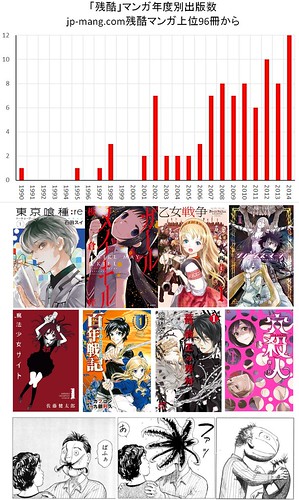
While the level of homicide (and youth crime) has been decreasing in Japan, it seems to me that there has been a contemporaneous increase in the number of violent Manga published.
The image above shows the number of "cruel" (残酷) manga published in each year based on a ranking of the same at jp-manga.com (link givenin bibliography). Parasyte (『寄生虫』) (1990) is the first published, tops the ranking and is reviewed below.
Before trailing off in 2015 and 2016 (possibly because the most recent manga have yet to develop a following) the numbers of cruel manga published increases to reach a peak in 2014 with such titles as "Tokyo Gu-ru:re" (東京グール:re about cannibals in Tokyo), "Girl May Kill" (ガール・メイ・キル about a cute looking assassin with a knife), Virgin Wars (乙女戦争 about 15th warrior girl in Bohemia), "Gnosis March" (グノーシス・マーチ about vampires), Magic Girl Site (魔法少女サイト about a girl that makes a pact with an evil web site), "One Hundred Years War" (百年戦争 about siblings, a brother and sister, forced to become mercenaries on opposing side of the titular war), "Funeral Procession of the Rose King" (薔薇王の葬列 about a hermaphrodite in the English Wars of the Roses), Hole Murderer (穴殺人 about someone who looks through a hole in a wall at the girl next door to find that she is a serial killer) and more, some of which are cruel in love rather than violence. The "violence" tag at the same website in a subset of the Yakuza genre rather than about violence in general. Some of the reason for the rise in the number of cruel manga in this ranking will be due to the fact that the site's viewers will be those reading manga now and thus more familiar with manga published recently.
While there are many that blame violence upon the proliferation of violent fiction in movies, animation and manga, it may conversely be the case that the proliferation of violent fiction provides a fictional outlet for violence which would otherwise manifest itself in reality.
I can't comment on how "cruel" most of these manga are since I have not read them. I can vouch for the fact that "Parasyte" (Iwaaki, 1990), The only manga in the above list that I have read, contained some pretty gruesome violence, cruelty. The violence often takes between men and women in scenes where alien parasites bite the heads off their date or spouse (as shown in the bottom row in black and white above). Alien parasite worms invade and grow to replaced the heads of their victims, who became headless bodies for a morphing, carnivorous Sphinx-head. The hero of the manga is a boy whose is invaded by an emotionless, ultra-rational parasite who only invades the boy's right hand, and acts as his assistant in dispatching the hand's head-invading brethren. The boy spends a lot of his time speaking to his hand. In the sense that he is spoken rather than seen by his paracyte, the hero is rather like a Westerner in Japan.
The violence in "Parasyte" was both graphic and particularly cruel due to the way in which the victims were often killed by a member of the opposite sex who they assumed loved them the most. The murderous opposite-sex partner (sibling, girl next door) trope seems to be continued in a more than one of the other seven manga listed.
Another review of Parasyte is here.
Bibliography
Iwaaki, H. (2011). Parasyte 1. New York: Kodansha Comics.
jp-manga.com (2016) Ranking of 残酷 manga, retrieved from www.jp-manga.com/list_t/%e6%ae%8b%e9%85%b7/all/default_1....
Should anyone wish that I cease and desist please be so kind as to contact me via the comments below or the mail link at nihonbunka.com. お取り下げご希望の場合は下記のコメント欄か、http://nihonbunka.comで掲示されるメールアドレスにご一筆ください。
Addendum
I can see now how Nietzsche was able to call his "spirit of gravity" a dwarf on his shoulders.
Labels: homicide, japanese culture, Nacalian, nihonbunka, 日本文化
Homicide in Japan
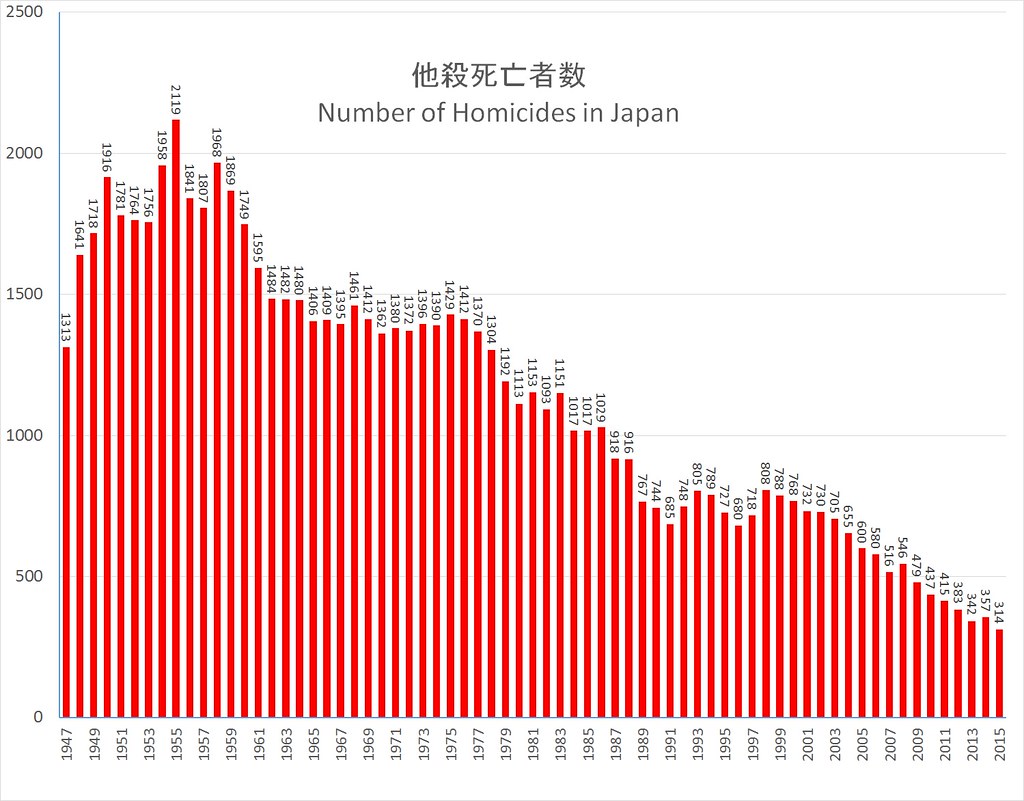
Japanese media, and indeed media around the world, become more effective in selling their products by alarming their audience, there is a tendency to believe that things are falling apart and that for instance, there is increased violence. In Japan the level of homicide has dropped by about 70 percent in the time that I have been here. Looking at Intentional Homicide Rates, Japan is now at a level bettered only by Andorra, Monaco, San Marino and Iceland. The next non small Island or City state of Austria has a muder rate almost twice that of Japan. In the UK the rate is about 3 times that of Japan and in the US thirteen times.
Labels: blogger, homicide, japanese culture, japaneseculture, murderrate, nihonbunka, 他殺, 推移, 日本文化
Sunday, October 09, 2016
Misunderstood Japan
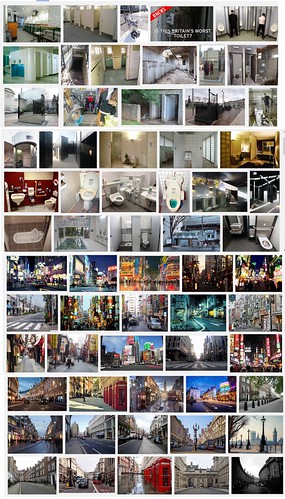
Someone asked on Quora what do foreigners misunderstand about Japan. I answered as I always do that Foreingers at least since Ruth Benedict (1946) think that Japanese shame is external, imposed on them from the outside, when in fact the Japanese live in the sight of the Sun God, Amaterasu, or Otendou-sama (Funahashi, 2008) who watches from within their hearts.
This explains why for instance, the Japanese do tidy up not only football stadia (even when their national team loses) but also tidy up in the privacy of their hotel rooms (Funahashi, 2008, p.166) and toilet cubicles which they leave as if unused, contra non-Japanese guests.
Conversely it is because Japanese care about how things look from a special perspective in their hearts, NOT from the point of view of other people, which is the reason why Japanese cities are a bristling, bubbling morass of individuality as opposed to rows of houses all looking the same.
The above images are the Google image search results, at half size, for:
I Top) British public toilet inside
2) Japan public toilet inside
3) Tokyo Street
4) London Street
お取り下げご希望でありましたら、下記のコメント欄かnihonbunka.comのメールリンクからご一筆ください。Should anyone want me to cease and desist please send me a note via the comments or to the mail link at nihonbunka.com
Labels: collectivism, individualism, japanese, japanese culture, nihonbunka, 個人主義, 日本文化, 集団主義
Friday, October 07, 2016
Walk the Walk
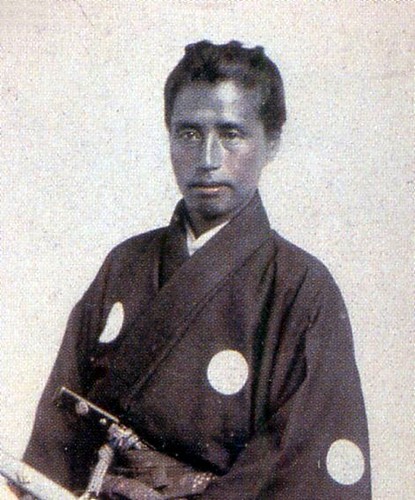
Kaishu Katsu pictured above was a late Edo period Bakufu government samurai who, with the approach of the Meiji restoration revolutionary forces, successfully argued for the surrender (or "opening") of Edo castle.
When the famous contemporary intellectual Yukichi Fukuzawa (who appears on 10,000 yen notes) criticised Katsu for a lack of stoic loyalty, which Fukuzawa felt he should have held onto, even in the face of defeat, Katsu responded with the following poem.
行蔵(こうぞう)は我に存(そん)す。
毀誉(きよ)は人の主張、我に与(あずか)らず我に関せずと存じ候(そうろう)。
各人へ御示し御座候とも毛頭異存(もうとういぞん)これなく候。
勝海舟
My acts are me, are mine
Blame and praise are what other people claim
Tell them to all the world for all I care not one hair
Knowing them to be nothing to do with I
Kaishu Katsu
He went on to lead the Japanese navy and become one of the most successful statesmen of the Meiji period.
Hiroshi Nakata's poem "the most precious thing" which appeared in his "Miracle" poem collection appears to be a homage to Katsu's earlier work.
思想は揚言のうちにない。
行蔵(こうぞう)のうちにしかない。
Our thoughts are not among the things we've said aloud
But only in the things we've done.
Image from Katsu Japanese language wikipedia page.
Separate Flesh One Heart Oath
 The Shinto shrine at which my wife and I were married gave us a wedding oath in which it was written that we were to remain "different bodies, but now with one heart" (異体同心).
The Shinto shrine at which my wife and I were married gave us a wedding oath in which it was written that we were to remain "different bodies, but now with one heart" (異体同心). This presents an interesting contrast with the conception of marriage as becoming one flesh in Genesis 24.
"21 So the LORD God caused a deep sleep to fall upon the man, and he slept; then He took one of his ribs [sides] and closed up the flesh at that place. 22 The LORD God fashioned into a woman the rib which He had taken from the man, and brought her to the man. 23 The man said, "This is now bone of my bones, And flesh of my flesh; She shall be called Woman, Because she was taken out of Man. 24 For this reason a man shall leave his father and his mother, and be joined to his wife; and they shall become one flesh."
I know that there is a Nacalian transformation to be had here -- well it is obvious and overt -- but I don't know what it means to become "one flesh."
Perhaps it goes like this.
In the West God, in one of his persons, listens and for the faithful becomes a comforter (paraclete, generalised other, impartial spectator, super addressee) shared by all, whereas visual perspectives are "dialogical" in the Bakhtinian sense, always polysemous, seen from the point of view of others, so that my face is not my self (Nishida), but "a face for a face" (in Nacalian inversion of Mori's "you for you"). While visuality in the West remains polysemous and subjective in general, among married couples ones appearance may become primarily above all for the eyes of ones spouse.
In Japan however the kind old sun is watching, and presents a gaze apart that his shared by all. However language remains polysemous so that in general the Japanese first person pronoun is as Arimasa Mori says no more than a "'You' for a 'You.'" However among Japanese married couples perhaps, the Japanese linguistic superaddressee becomes ones spouse.
In each case, therefore, perhaps "our better half" takes the place of the perspective not occupied by God. I can see how that might work to make Western couples one flesh (c.f. Terrence Malik's ""We were a family... Each standing in the other's light.") but it is pretty strange to me that a Shinto Shrine might, under this interpretation, call the self-narrative the heart.
But then again, Shinto has become very wordy post-Meiji, modelling itself upon Western monotheisms and handing out oaths like this, and may even have forgotten, like Prime Minister Abe, and Seiichi Tsuruta (鷲田清一) that the Japanese heart is a mirror. In this morning's Asahi Newspaper Professor Tsuruta came back to his senses.
Farmer Poet Gives Voice to the Things that say Nothing
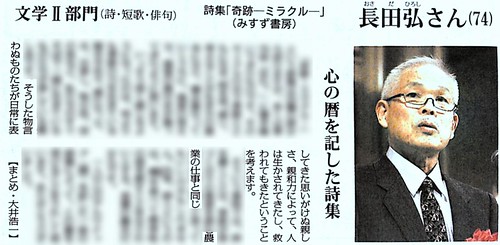
In today's Asahi Newspaper the philosopher Seiichi Tsuruta, who is usually very "Western" in his belief that the self is essentially linguistic, returned to his senses and chose for today's "words of the moment" (ことばのおりおり") the following excerpt from the poet Hiroshi Nagata who died, at age 75, in May last year.
人は、ことばを覚えて、幸福を失う。
そして、覚えたことばと
おなじだけの悲しみを知る者になる。
長田弘
People learn words, and lose happiness.
And with the words they learn
They become sage with same amount of sadness.
Hiroshi Nagata
Yesss;-;
I often find it difficult to persuade people that I came from the country of words, to the land of light, at least partly because there are so many brilliant Japanese novelists and poets. It seems to me however that so many of the best Japanese novelists and poets, and the most famous haiku poetic style -- aims to take us with words away from them, back to the things that say nothing.
In his acceptance speech for the Mainichi Newspaper poetry prize as summarized in the article from the same newspaper above, the poet describes his art in the following way.
"Through my art, the basis of my life has become living with the seasons, seeing things, feeling them, thinking them, and this has allowed me to see my environment (風景 scenery) in a different way.
By this means I have been moved ever more profoundly by closeness or affinity expressed by the trees, flowers, birds, earth, water, sunlight, the colour of things that live the power of the seasons along side with us. I think it is through the amazing affinity and closeness of these things that say nothing that people are given life and saved.
In this way, I think that it is fair to say that being a poet is the same as being a farmer who also reads the things that give breath to the days of the seasons. From days past the poet has been the farmer of words whose profession has been harvest sensitivity eating only the mist. I am very pleased to receive this prize for my collection of poetry which contains an almanac of one person's heart. "(My emphasis, Original Precis by Kouichi Ooi, Mainichi Newspaper, 2014/1/30 posted here)
お取り下げご希望の場合は下記のコメント欄か、http://nihonbunka.comで掲示されるメールアドレスにご一筆ください。
Labels: japanese culture, nihonbunka, 日本文化
Wednesday, October 05, 2016
Shinto Prayer and the First Person Self

Japanese people traditionally prayed at Shinto shrines without words, but by bowing deeply twice, clapping twice, and bowing once again.
The bow before a shrine, and the spirit within it, is the most formal of bows otherwise reserved only for extremely respected persons, where the torso is brought to within 90 degrees of the legs. This is not quite as radical, perhaps, as a Tibetan Buddhist and Muslim prostration in which one brings ones forehead into contact with the ground but, first of all, it encourages those at prayer to feel humility which, at least in Japan, is generally thought to be a good thing.
The clapping part of the Shinto prayer struck me as a reminder of the fact that not only can I whisper (think) and speak but I can make noises with my body, so thus draws me away towards an active awareness of the autonomy of my embodiment: look, your body, your hands too speak.
But now it occurs to me that Shinto prayer may be a way of encouraging an awareness of the first person self: the self which sees itself.
As I often point out, there are a large number of scholars that emphasise the need for an intra-psychic other in order to be aware of self. In the words of many social scientific researchers we take in the perspective of another (Haidt, 2001; Hermans & Kempen, 1993; Markus & Kitayama, 1991; Mead, 1934/1967) such as when we address our thoughts to absent friends. This phraseology emphasising the interiorisation or internalisation of something sounds natural and persuasive.
Rochat (2009) however points out that the adult self, as represented by the pronoun "I" or as seen as reflected in the mirror, is a self for others: a "third-person self". The me in the mirror is not anything that I will ever see on this side of the glass, but only something that others can see. And though we use a different pronoun for "I" as opposed to "me," as Mori points out unless there is a "third person" the "I" is a "you for you," an explanation of me, for others. Though both are only representations, we get used to thinking that we are one or the other. Usually in the West we tend to identify with the hero of our self narrative as many scholars (e.g. Dennet, 1992) attest despite the fact that it is becoming plain that our self-narrative, this whispering that we listen to, is not "will" but an excuse after the event (Nisbett & Wilson, 1977).
Rochat (2009) takes a different view. He reminds us that children have a first person self prior to their third person representations of themselves. That is to say that we can hear, see, and touch ourselves, and in all cases become aware of our movements and distinguish between self originating movement - the double touch, sound variations that we have created, closed circuit videos - and other generated movement -- the single touch by another object, sounds created randomly, delayed movements on video tape. Rochat argues that our adult sense of self arises out of a "negotiation" between these two self positions. That is to say that the first person self remains, and it is from this perspective from which our third person self-representions are seen and heard.
In other words it less that we take the perspective of others into our heads as it were, or internalise, introject, internalise a mode of others in our minds, but really that we extroject a model of ourselves (as narrative and image) and forget the first person self that is watching.
How might we become aware of this first person self (assuming we want to)? I have suggested wearing spectacles, looking at ones nose, and touching ones face.
It also seems to me now that Shinto prayer encourages the worshipper to become aware of their first person self. Bowing deeply we see our own legs. Clapping we see our hands, their movement, their "double touch" as palms meet, and their self-created clapping sound. By so doing perhaps we remember just a little, the giant that we have forgotten is staring out of our eyes.
Perhaps I could use bowing and clapping as independent variables, or take up Shinto again.
Labels: blogger, japanese culture, japaneseculture, nihonbunka, philob, 日本文化
Tuesday, October 04, 2016
Japanese and Foreign Hotel Guests

In "The Kind Old Sun is Watching Over us" Yoshiyuki Funahashi (2008) writes
"Rethinking the Manners of the Japanese
Here I'll start by writing about how the manners of the Japanese are no so bad in comparison to those of foreigners.
I heard this from someone who works in a hotel.
There is a clear difference between Japanese and foreign guests after they have finished with a room. Japanese guests put the sheets and futon back into shape, and also clean up the wash basin. In the case of refuse (rubbish/trash) too, when there are two bins one for burnable and another for non-burnable refuse, Japanese guests tend to separate their refuse into the appropriate bin. By comparison foreign guests tend not to clean up after themselves, and leave their rooms in quite a state." (Funahashi, 2008, p166, my translation).
I have used a British flag on the lower messier picture of a hotel room merely for illustrative purposes. The text groups all non-Japanese into one category of "foreigners". My guess is that there may be hotel guests from nations other than Japan, who also leave their rooms in a similarly neat and tidy way. I confess, however, it would hardly cross my mind to clean up my hotel room before departure. Part of the joy of staying in a hotel room is that I am able to leave the cleaning to someone else. Sometimes to save the cleaning staff work, I leave one of those dongles on the doorknob to tell the cleaners not to bother to clean up today. But often I make use of the service, considering it part of the luxury that I am paying for.
The kindness of the Japanese in cleaning up their hotel rooms after they leave may appear almost neurotic to British eyes. The reason for this behaviour lies in title of the book from which the above extract was taken. The Japanese live in the sight of the kind old Sun. That is to say, their ancestors and spirits, their soul, watches and protects. It is from this visual perspective that Japanese evaluate themselves so their mess can not be rationalised ("it is part of the luxury", "I am paying for it") away. To the Japanese "impurity" or mess is mess and has to be cleared up by someone. So, seeing this, and seeing it is not beautiful, Japanese guests make the situation beautiful themselves.
The above is just as the author goes on to conclude. To the Japanese author, "Dirty appearances are the sign of a dirty heart" (見た目の汚れは心の汚れの現われです. p173).
Before the notion of "morality" had been invented, when people of old went to do something that was bad, or something that they'd regret, they felt "the kind old sun is watching" and controlled themselves and censured others.
Even if others are not not watching, if only the kind old sun is in your heart, you put a break on bad behaviour, and put your foot on the accelerator when you do good things. (昔の人は、道徳という概念がない時代から、何か悪いことをしようとしたときや、後ろめたいことをするときなどは、「お天道さまがみてござる...」と自分を律したり、他人をたしなめたものです。
たとえ人が見ていなくても、お天道さまが心の中にさえいれば、悪いことをするときはブレーキがかかりますし、善いことをするときはアクセルを踏むことができます。) p181
Eat your heart out Ruth Benedict (1946/2006)!
This is just the sort of quote I was looking for because it takes place in the privacy of a hotel room. The mess, or rather its absence, will not be seen in many cases until after the guest has left and is walking down the street, never to stay at that hotel again. And yet, even in the absence of all external censure, the Japanese guest will often have cleaned up their room, whereas I will have whispered some rationalisation to myself and left my room in a state like the aftermath of a fraternity party.
Britons have aspects which are "not so bad" either. Having checked out of my room I may be slightly more inclined to leave a nice long verbal review of my hotel room, and this book, since this is the sort of evaluation that my logocentric, narrative self encourages me to do.
In both cases good and bad behaviour is not about external censure but about conscience, and the nature of the self.
Image
Random hotel rooms in which I have stayed, flags Japanese and British and the Cover of Funahashi's book. お取り下げご希望の場合は下記のコメント欄か、http://nihonbunka.comで掲示されるメールアドレスにご一筆ください。
Bibliography
Benedict, R. (2006). The Chrysanthemum and the Sword. Houghton Mifflin Harcourt. (Original work published 1946)
舟橋淑行. (2008). お天道さまが見てござる―よみがえる日本の心. 東京: 明窓出版.
It would be good to do a quantitative survey.
Labels: blogger, japanese culture, nihonbunka, 日本文化
Monday, October 03, 2016
Shame and Visual Culture
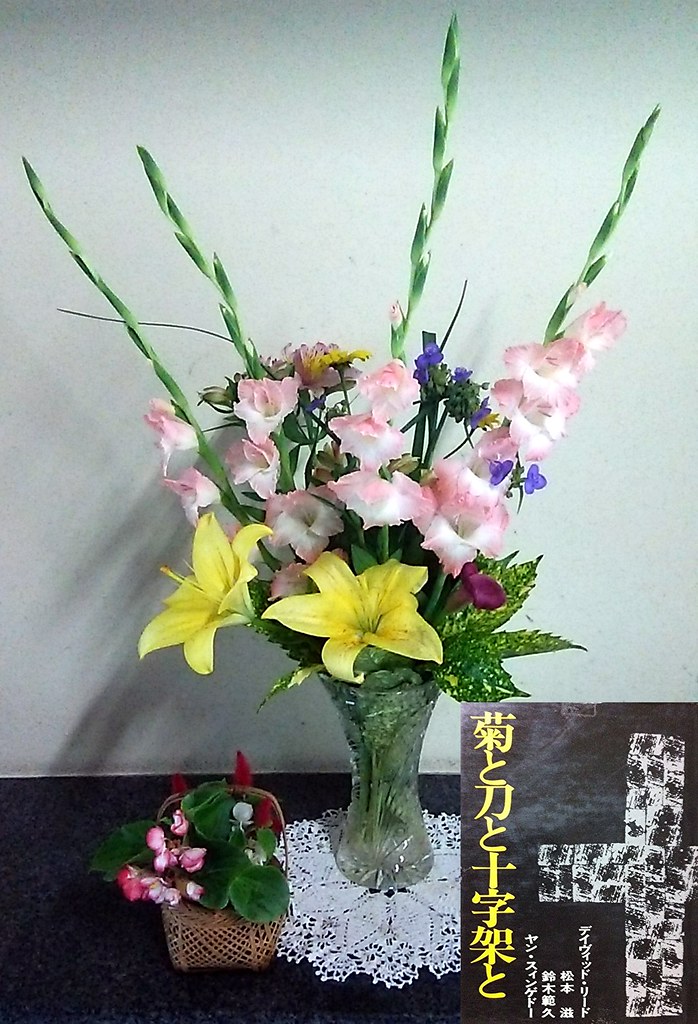
Rev Joshiba's essay on guilt and shame is a good summary of the various theories regarding their difference. He mentions one author, likewise a Christian, who shares a similar appraisal of Japanese culture to myself. Joshiba summarizes [28] 鈴木範久が『菊と刀と十字架と』で指摘した点はその意味でも興味深い。鈴木はそこで、日本は主として生け花・日本料理・和服・絵画など視覚型文化を発展させてきたが、恥は「見る・見られる」という視覚を前提とすると言っている(p50-51)。 In "The Chrysanthemum, the Sword and the Crucifix", Norihisa Suzuki makes an interesting point. Suzuki says that the Japanese have a developed a visual mode of culture in their flower arrangements, cuisine, clothing, and pictorial art and shame assumes a the visual sense of seeing and being seen (p50-51). Quite so. Vision is no more external than language but hearing oneself "whispering" (which is what we now know linguistic thought to be) is worse because it hides its externality more effectively, and always makes contrasts, slagging off other people, groups and things, as I am doing now.
Labels: blogger, japanese culture, nihonbunka, 日本文化
This blog represents the opinions of the author, Timothy Takemoto, and not the opinions of his employer.

